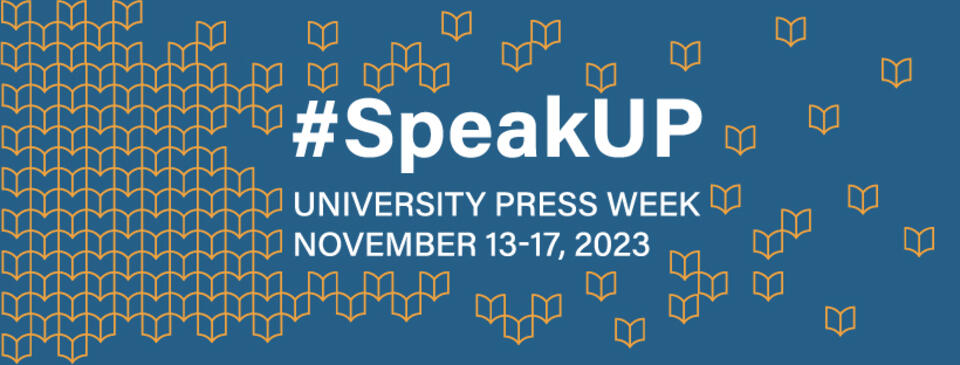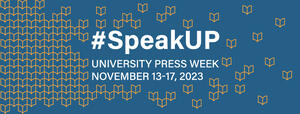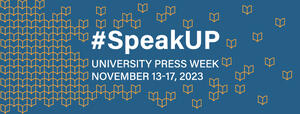
UP Week 2023: How Does Your Press #SpeakUP?
Accessibility
Every year, the Association of University Presses (AUP), of which we are a proud member, takes a tour of UP blogs. This daily series addresses different aspects of the week’s theme. This year, blog tour posts will examine ways that university presses Speak UP, or give voice to the scholarship and ideas that shape conversations around the world.
A major subject on every university press’s tongue these days is accessibility, and for good reason. Regardless of the introduction of stronger accessibility laws here and in the EU, making our ePubs accessible is the ethically and morally responsible thing to do, for both the author and the press. By doing so, we make our titles available to a broader audience; we further our mission to be more equitable and inclusive; and we expand our authors’ ideas and research so that more readers can participate in the countless conversations that are happening in institutions and beyond. It’s important, and it’s necessary.
But doing the right thing is complex, and it’s far from simple. There’s a lot of information available out there with limited practical application for those who aren’t already experts in HTML, CSS, XML, and all the other acronyms that only an expert computer programmer can really appreciate (and apply to the various programs used to create an eBook). It’s no secret that university presses are operating with reduced budgets, personnel, and other resources, so advances are slow (and maybe even a little painful).
Though I have worn many hats in my publishing career and am currently Manager of Training, Development and Services, historically I’m a production editor. I can pivot fast, and I also like a good dare. So, I accepted the challenge and immersed myself to get up to speed. I Googled and read as much as my brain could absorb; I watched every webinar and video I could find, even ones only tangentially related. I talked to all manner of people connected to our university about accessibility and got myself involved with an accessibility working group and listserv to trade ideas. I completed mandatory accessibility training, which left me feeling overwhelmed. I ran multiple test projects and failed. I met with multiple certified conversion vendors and crunched numbers (which is not really my forte) to see if they fit in our budget (spoiler: they don’t). I participated in conferences and discovered I’m not alone in my frustration. I added a few new procedures and contributed videos to my colleagues’ training library. I taught myself how to understand cascading style sheets and reintroduced myself to HTML so I could do quality assurance of our ePubs, and I might have even gotten the idea that with my moderate understanding of InDesign I could teach myself how to export a proper ePub from it (and also manually and successfully remediate a PDF), and I would be a silent hero. I’ve also discovered that with new information comes new setbacks, and I’ve sometimes felt like I’m back where I started and wondering who I can email, who can guide me, who can practically tell me how I make things right at the beginning when I have no control over who does what at the end.
Suffice to say that I still have more questions than I have answers, but I know we’re moving in the right direction. Every press employee has taken Deque University’s accessibility training so we can be better informed. Our university has assessed our website for accessibility shortcomings and we’ve begun addressing our ongoing accessibility efforts on our website (https://sunypress.edu/Requests/Accessibility). We’ve partnered with Bookshare, an organization that makes books fully accessible by request, so that the need to make titles accessible doesn’t completely hinge on our limited competency. We have implemented policy and procedures for adding alt text to images, ensuring tables are simple, and including additional descriptive text with graphs and charts, and this will be seen in our books pubbing in 2024. We’re guiding authors on how to create effective alt text. We’re giving them examples of how to make tables concise. We’re doing our best to explain why visual elements such as bolding, italics, or color are not accessibility friendly. I’ve updated documentation (both internally and externally) to capture these changes.
To some, this might sound like a lot, but I’m disappointed at the rate of progress, and there’s so much more yet to solve. I also know I’m not alone. I’m grateful for how enthusiastically the university press and academic space share their successes and failures. I’ve received more resources than I could probably read in a year, and I get more every day. I’ve applied for AUP’s Week in Residency grant with the sole purpose of gaining and sharing more information and perspective about accessibility from two member presses who are in proximity to each other (fingers crossed). And I’m grateful for all the conversations resulting in the reality that you’re doing OK if you’re doing any of these things. Is there still more to do? Absolutely. Will we get there? I really hope so. Knowing that we as a community are all working toward this goal together has made all the difference.

